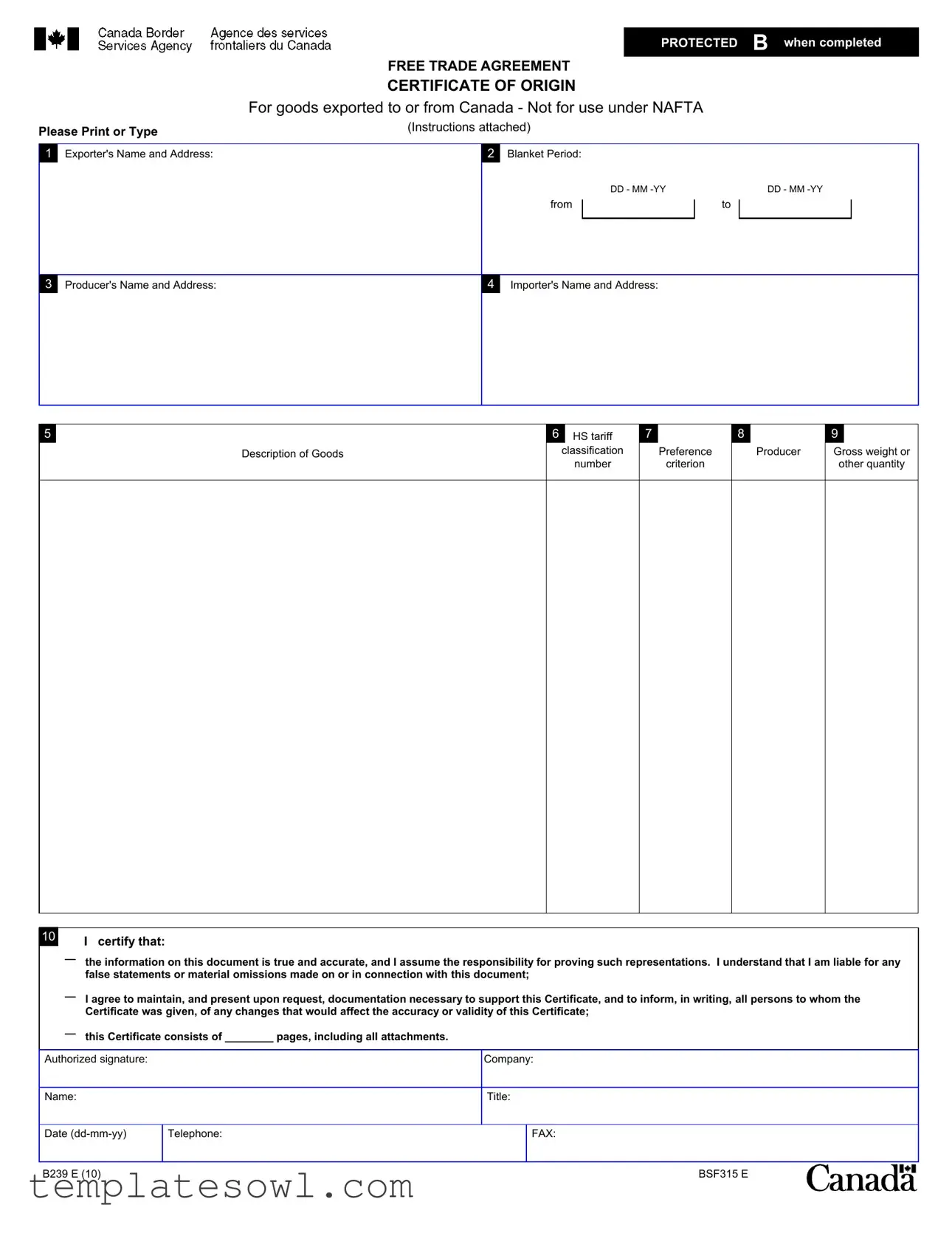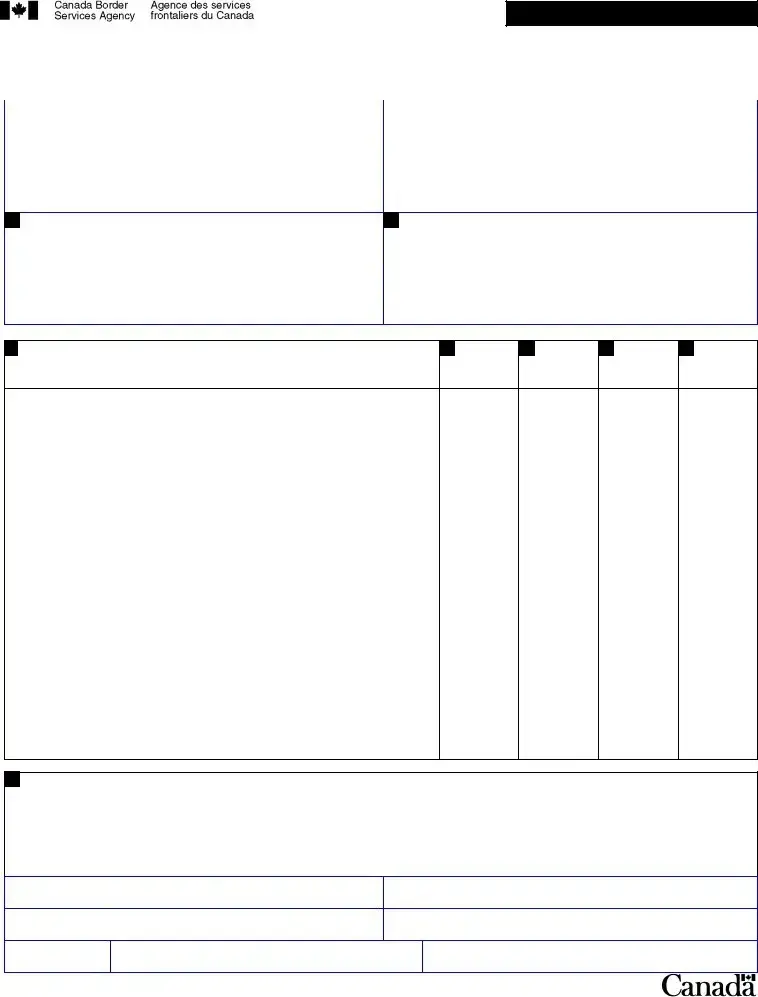PROTECTED B when completed
FREE TRADE AGREEMENT
CERTIFICATE OF ORIGIN
For goods exported to or from Canada - Not for use under NAFTA
Please Print or Type |
(Instructions attached) |
|
|
|
|
|
|
|
|
|
|
|
|
|
|
|
|
|
|
|
1 |
Exporter's Name and Address: |
|
2 |
Blanket Period: |
|
|
|
|
|
|
|
|
DD - MM -YY |
|
DD - MM -YY |
|
|
|
|
|
|
|
|
|
|
|
|
from |
|
to |
|
|
|
|
|
|
|
|
|
|
|
3Producer's Name and Address:
4Importer's Name and Address:
6HS tariff
classification
number
9
Gross weight or
other quantity
10I certify that:
—the information on this document is true and accurate, and I assume the responsibility for proving such representations. I understand that I am liable for any false statements or material omissions made on or in connection with this document;
—I agree to maintain, and present upon request, documentation necessary to support this Certificate, and to inform, in writing, all persons to whom the Certificate was given, of any changes that would affect the accuracy or validity of this Certificate;
—this Certificate consists of ________ pages, including all attachments.
FREE TRADE AGREEMENT
CERTIFICATE OF ORIGIN INSTRUCTIONS FOR GOODS EXPORTED TO OR FROM CANADA -
NOT FOR USE UNDER NAFTA
For purposes of obtaining preferential tariff treatment, this document must be completed legibly and in full by the exporter and be in the possession of the importer at the time the declaration is made. Please print or type.
Field 1: State the full legal name and address of the exporter.
Field 2: Complete this field if the certificate covers multiple shipments of identical goods, as described in Field 5, that are imported for a specified period of up to one year (blanket period). "From" is the date upon which the certificate becomes applicable to the good covered by the blanket certificate (it may be prior to the date of signing this certificate). "To" is the date upon which the blanket period expires. The importation of a good for which preferential tariff treatment is claimed based on this certificate must occur between these dates.
Field 3: State the full legal name and address of the producer. If more than one producer's good is included on the certificate, attach a list of the additional producers, including the legal name and address cross referenced to the good described in field 5. If you wish this information to be confidential, it is acceptable to state "Available to customs upon request." If the producer and the exporter are the same, complete field with "Same." If the producer is unknown, it is acceptable to state "Unknown."
Field 4: State the full legal name and address of the importer. If the importer is not known, state "Unknown"; if multiple importers, state "Various."
Field 5: Provide a full description of each good. The description should be sufficient to relate it to the invoice description and to the Harmonized System (HS) description of the good. If the certificate covers a single shipment of a good, i.e., it is not a blanket certificate, include the invoice number as shown on the commercial invoice. If not known, indicate another unique reference number, such as the shipping order number.
Field 6: For each good described in Field 5, identify the HS tariff classification to six digits. If the good is subject to a specific rule of origin that requires eight digits, identify to eight digits, using the HS tariff classification of the Party into whose territory the good is imported.
Field 7: For each good described in Field 5, state which criterion (A through E) is applicable. The rules of origin are set out in the regulations enacted and published by the Parties.
Note: In order to be entitled to preferential tariff treatment, each good must meet at least one of the criteria below.
Preference criteria
AThe good is "wholly obtained or produced entirely" in the free-trade area.
Note: The purchase of a good in the free-trade area does not necessarily render it "wholly obtained or produced."
BThe good is produced entirely in the free-trade area and satisfies the specific rule of origin that applies to its tariff classification. The good must also satisfy all other applicable requirements.
CThe good satisfies, as a result of production occurring entirely within the free-trade area, the applicable requirements set out in the specific rule of origin where no change in tariff classification is required in that rule.
DThe good is produced entirely in the free-trade area exclusively from originating materials. Under this criterion, not all materials need to fall within criterion A. However, all materials used in the production of the good must qualify as "originating" by meeting the rules of one of the preference criteria.
Goods are produced in the free-trade area but do not meet the applicable specific rule of origin because certain non-originating materials do not
Eundergo the required change in tariff classification. This criterion is applicable only where the good incorporated one or more non-originating materials, provided for as parts under the HS, which could not undergo a change in tariff classification because the heading provides for both the good and its parts and was not further subdivided into subheadings, or the subheading provided for both the good and its parts. Furthermore, at least one category of identical or similar materials provided for in that heading or subheading must be originating.
Note: This criterion does not apply to Chapters 61 through 63 of the HS
Field 8: For each good described in Field 5, state "Yes" if you are the producer of the good. If you are not the producer of the good, state "No" followed by (1) or (2), depending on whether this certificate was based upon: (1) your knowledge of whether the good qualifies as an originating good or (2) your reliance on the producer's written representation that the good qualifies as an originating good.
Field 9: Where the certificate is not a blanket certificate indicate the gross weight or number of pieces in the shipment.
Field 10: This field must be completed, signed, and dated by the exporter. The date must be the date the certificate was completed and signed.


